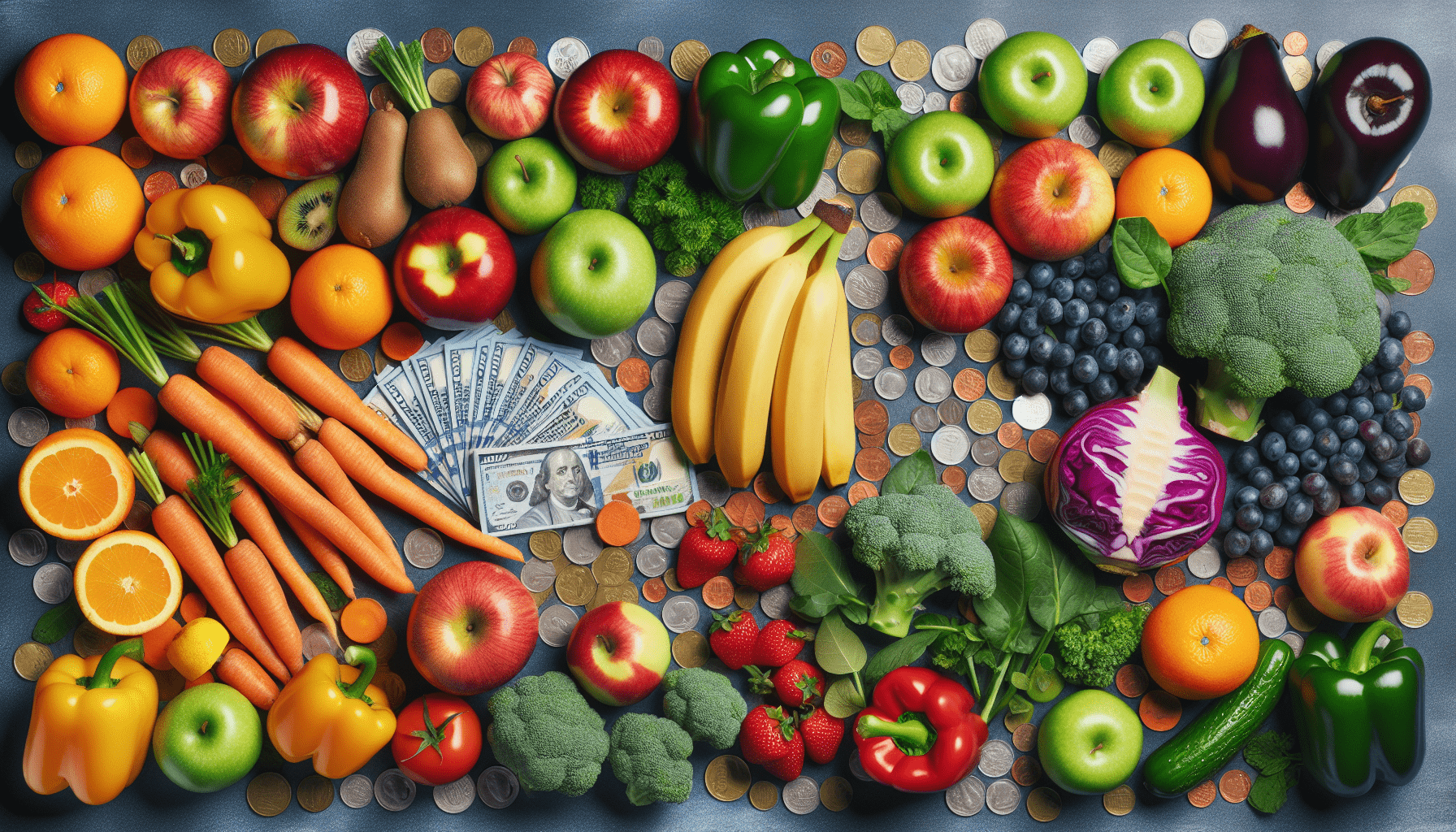In today’s busy world, it can be challenging to maintain a healthy lifestyle while also sticking to a budget. But fear not! In this article, we will show you how to achieve your weight loss goals without breaking the bank. We will explore budget-friendly meal planning, affordable grocery shopping tips, and creative ways to make nutritious meals without spending a fortune. Remember, it’s always a good idea to consult a health professional before making any significant changes to your diet or exercise routine. Let’s get started on your journey to a healthier you!
Discover the Ultimate Weight Loss Secrets Here!
1. Plan your meals and make a grocery list
1.1 Calculate your caloric needs
Before you start planning your meals, it’s important to determine your caloric needs. This will help you understand how much you should be eating in order to maintain or lose weight. You can use online calculators or consult with a nutritionist to get an accurate estimate of your daily calorie intake.
1.2 Plan your meals for the week
Once you know your caloric needs, it’s time to plan your meals for the week. Start by deciding on the number of meals and snacks you’ll have each day. Take into consideration your schedule, preferences, and dietary restrictions. Aim for a balance of protein, carbohydrates, and fats with each meal.
1.3 Check your pantry and refrigerator
Before heading to the grocery store, take a look at what you already have in your pantry and refrigerator. This will help you avoid purchasing unnecessary items and ensure that you’ll use what you already have before it expires. Make a note of any ingredients you’ll need to complete your planned meals.
1.4 Make a grocery list
With your meal plan in mind, make a comprehensive grocery list. Organize your list by sections, such as produce, proteins, grains, and pantry staples. This will help you navigate through the store more efficiently and avoid impulse purchases. Stick to your list and avoid buying items that are not necessary for your meal plan.
2. Buy in bulk and stock up on sale items
2.1 Benefits of buying in bulk
Buying in bulk can be a great way to save money on your grocery bill. Not only will you typically get a lower price per unit, but you’ll also reduce packaging waste. Look for staples like rice, beans, oats, and nuts that have a long shelf life and are frequently used in your meal plan.
2.2 Look for sale items and discounts
Keep an eye out for sale items and discounts at your grocery store. Many stores offer weekly specials on produce, meats, and pantry staples. Plan your meals around these discounted items to save even more. Additionally, consider joining loyalty programs or using coupons to further reduce your grocery costs.
2.3 Comparison shop and use coupons
Don’t be afraid to compare prices at different stores to find the best deals. Certain items may be priced lower at one store compared to another. Use mobile apps or websites to check prices and see if any coupons are available. Remember to only buy what you need and will use to avoid wasting money on unnecessary items.
2.4 Buy seasonal produce
Seasonal produce is often less expensive and tastes better since it’s harvested at its peak. Fruits and vegetables that are in season are more abundant, which leads to lower prices. Take advantage of this by incorporating a variety of seasonal produce into your meals. You can also freeze or preserve extra produce to enjoy during non-seasonal periods.
Click Here for Proven Fat-Burning Strategies!
3. Cook and prepare meals at home
3.1 Benefits of cooking at home
Cooking and preparing meals at home is not only healthier but also more cost-effective. By cooking your own meals, you have full control over the ingredients and portion sizes. Eating out or ordering takeout can be more expensive and often leads to consuming larger portion sizes and unhealthy ingredients.
3.2 Meal prepping and batch cooking
Meal prepping and batch cooking can save you time and money throughout the week. Dedicate some time on the weekend to prep and cook large batches of grains, proteins, and vegetables that can be used in multiple meals. Portion these out into individual containers, ready to grab when you’re in a rush or don’t feel like cooking.
3.3 Use affordable ingredients
Opt for affordable ingredients when planning your meals. Staples like beans, lentils, whole grains, and seasonal vegetables are not only budget-friendly but also provide essential nutrients. Look for recipes that highlight these ingredients and experiment with different flavor combinations to keep things interesting.
3.4 Avoid processed foods and convenience meals
Processed foods and convenience meals tend to be more expensive and often lack nutritional value. Instead of relying on these options, focus on using whole foods that you can prepare at home. Not only will this help you save money, but it will also support your overall health and weight loss goals.
4. Opt for plant-based proteins
4.1 Beans, legumes, and lentils
Beans, legumes, and lentils are affordable sources of plant-based protein. They are not only cost-effective but also rich in fiber and other important nutrients. Incorporate these versatile ingredients into your meals by making bean salads, lentil soups, or chickpea curries. They can be the star of your meal, replacing meat, or used as a protein-rich side dish.
4.2 Tofu and tempeh
Tofu and tempeh are great plant-based protein options that are readily available and relatively inexpensive. They can be used in a variety of dishes, such as stir-fries, salads, or sandwiches. Experiment with different cooking methods and marinades to enhance their flavors and textures.
4.3 Quinoa and other whole grains
Whole grains like quinoa, brown rice, and barley not only provide protein but also offer nutritional benefits like fiber, vitamins, and minerals. These grains can be used as a base for meals or added to soups, stews, and salads. Buying these grains in bulk can be more cost-effective in the long run.
4.4 Eggs and Greek yogurt
Eggs and Greek yogurt are affordable and versatile sources of protein. They can be enjoyed in a variety of ways, such as omelets, scrambled eggs, or as a topping for yogurt bowls and smoothies. If you’re looking to save money, consider buying these items in larger quantities or looking for sales and discounts.

Unlock Your Path to a Healthier You!
5. Include plenty of fruits and vegetables
5.1 Seasonal and local produce
Incorporating seasonal and local produce into your meals can save you money, as these items are often less expensive than out-of-season or imported produce. Visit farmer’s markets or join a local community-supported agriculture (CSA) program to access fresh, affordable fruits and vegetables. You’ll also be supporting local farmers and reducing your carbon footprint.
5.2 Frozen fruits and vegetables
Frozen fruits and vegetables are a convenient and cost-effective alternative when fresh produce is not in season or available. They are picked and frozen at their peak ripeness, retaining most of their nutrients. Use frozen fruits in smoothies, oatmeal, or baking, and add frozen vegetables to soups, stir-fries, or pasta dishes.
5.3 Grow your own herbs and veggies
If you have the space and resources, consider growing your own herbs and vegetables. It can be a rewarding experience and save you money in the long run. Herbs like basil, mint, and parsley are easy to grow in small pots, and vegetables like tomatoes, lettuce, and peppers can thrive in a backyard or balcony garden.
5.4 Ways to incorporate fruits and veggies into meals
There are countless ways to incorporate fruits and vegetables into your meals. Add slices of cucumber, tomatoes, or lettuce to sandwiches and wraps. Make salads with a variety of colorful vegetables, fruits, and protein sources. Blend leafy greens into smoothies or puree them into pasta sauces. Get creative and experiment with different combinations to find what you enjoy the most.
6. Choose affordable and nutrient-dense foods
6.1 Oats and whole grains
Oats and other whole grains are not only affordable but also provide essential nutrients and fiber. They can be used as a base for breakfast bowls, added to baked goods, or used as a thickener in soups and stews. Look for sales or bulk options to get the most value for your money.
6.2 Canned and frozen fruits
Canned and frozen fruits can be a cost-effective option, especially when fresh options are not available or are more expensive. Opt for canned fruits packed in water or their own juice rather than heavy syrup. Frozen fruits are great for smoothies, baking, or enjoying as a refreshing frozen treat.
6.3 Canned and frozen vegetables
Similarly, canned and frozen vegetables can be convenient and affordable choices. Look for low-sodium options when buying canned vegetables. When using frozen vegetables, steam or sauté them to retain their nutrients and taste. They can be easily added to soups, stir-fries, or casseroles.
6.4 Healthy fats like nuts and seeds
Healthy fats, like those found in nuts and seeds, are essential for a balanced diet. They can be quite expensive, but you can save money by buying them in bulk or during sales. Consider buying whole nuts and seeds and roasting them yourself for added flavor. Use them as toppings for salads, oatmeal, or yogurt, or incorporate them into homemade granola or energy bars.
7. Minimize waste and repurpose leftovers
7.1 Plan meals using leftovers
Plan your meals in a way that allows you to use leftovers creatively. For example, roast a whole chicken and use the leftovers in salads, sandwiches, or stir-fries the next day. Cook extra grains or pasta that can be repurposed into cold salads or added to soups. Being mindful of leftovers will not only save you money but also minimize food waste.
7.2 Get creative with leftovers
Get creative with your leftovers to avoid boredom and maximize your meals. For instance, turn leftover roasted vegetables into a flavorful frittata or blend them into a soup. Use leftover proteins like chicken or beef in tacos, wraps, or as a topping for salads. The possibilities are endless when you think outside the box.
7.3 Store food properly to extend shelf life
Storing food properly can help extend its shelf life and prevent unnecessary waste. Invest in airtight containers or use resealable bags to store leftovers in the refrigerator or freezer. Check the temperature of your refrigerator to ensure it’s set at the optimal level to keep food fresh. Label and date items to keep track of when they need to be used or discarded.
7.4 Reduce food waste
Reducing food waste is not only good for your budget but also for the environment. Plan your meals and grocery shopping based on what you’ll realistically consume. Freeze perishable items like bread or fruits that you’re unable to use before they spoil. Get creative with lesser-used parts of ingredients, such as using vegetable scraps to make flavorful homemade broth.
8. Drink water and limit sugary beverages
8.1 Benefits of drinking water
Drinking water is not only essential for hydration but also for weight loss and overall health. It has zero calories, is readily available, and costs significantly less than sugary beverages. Aim to drink at least 8 cups (64 ounces) of water per day and more if you’re physically active or live in a hot climate.
8.2 Infuse water for flavor
If you find plain water boring, infuse it with natural flavors to make it more enjoyable. Add slices of lemon, lime, cucumber, or berries to a pitcher of water and let it sit for a couple of hours in the refrigerator. You can also try herbs like mint or basil to add a refreshing twist.
8.3 Limit sugary drinks and soda
Sugary drinks and soda not only add empty calories to your diet but also contribute to weight gain and other health issues. Limit your intake of these beverages and opt for healthier alternatives like herbal tea, flavored water, or sparkling water with a splash of fruit juice. Reduce your dependence on sugary drinks and you’ll save money while improving your health.
8.4 Make your own healthy beverages
Save money by making your own healthy beverages at home. Brew your own iced tea, make homemade lemonade with fresh lemon juice and a natural sweetener like honey or stevia. Experiment with different combinations of fruits, vegetables, and herbs to create refreshing smoothies or mocktails.

9. Use spices and herbs for flavor
9.1 Benefits of using spices and herbs
Using spices and herbs to flavor your meals is a great way to add taste without adding extra calories or expensive ingredients. They are also rich in health-promoting compounds and can offer various health benefits. Experiment with different spices and herbs to enhance the flavors of your meals and keep your taste buds satisfied.
9.2 Affordable and versatile seasonings
Some spices and herbs can be quite expensive, but there are plenty of affordable options that offer great flavor. Staples like salt, pepper, garlic powder, onion powder, and paprika are versatile and can be used in a wide range of dishes. Look for sales or buy in bulk to get the most value for your money.
9.3 Experiment with different flavor combinations
Don’t be afraid to experiment with different flavor combinations to keep your meals interesting. Mix and match spices and herbs to create unique profiles for your dishes. For example, try combining cumin, coriander, and turmeric for a flavorful curry powder, or use basil, oregano, and thyme for an Italian-inspired herb blend.
9.4 Make your own spice blends
Instead of buying pre-made spice blends, consider making your own at home. Not only will this save you money, but it will also allow you to customize the flavors according to your preferences. Mix together your favorite spices and herbs, adjust the ratios to achieve the desired taste, and store them in airtight containers for later use.
10. Seek professional guidance
10.1 Importance of consulting a health professional
While these tips can help you eat healthy on a budget and support weight loss, it’s important to consult a health professional before making any significant changes to your diet or exercise routine. A registered dietitian or nutritionist can provide personalized advice based on your specific needs, health conditions, and goals.
10.2 Personalized advice and support
A health professional can provide personalized advice and support to help you achieve your weight loss goals while sticking to a budget. They can help you create a meal plan that suits your dietary preferences, educate you about portion sizes and balanced meals, and offer guidance on food choices and substitutions.
10.3 Monitoring progress and adjusting
Working with a health professional allows you to monitor your progress and make necessary adjustments to your plan. Regular check-ins can help you stay accountable and motivated, while also providing an opportunity to address any concerns or challenges you may be facing. They can help you fine-tune your approach as you continue on your weight loss journey.
10.4 Working with a nutritionist or dietitian
Seeking the guidance of a nutritionist or dietitian can be an invaluable investment in your health and weight loss journey. They have the knowledge and expertise to offer evidence-based advice tailored to your individual needs. They can help you navigate through the challenges of eating healthy on a budget, making it a sustainable and enjoyable lifestyle change.
In conclusion, eating healthy on a budget is not only possible but also rewarding. By planning your meals, buying in bulk, cooking at home, incorporating affordable ingredients, and making smart choices, you can achieve weight loss without breaking the bank. Remember to seek guidance from a health professional to ensure that your diet plan aligns with your individual needs and goals. Consultation with a registered dietitian or nutritionist is important before making any significant changes to your diet or exercise routine. Making informed decisions about your health is essential for long-term success.

